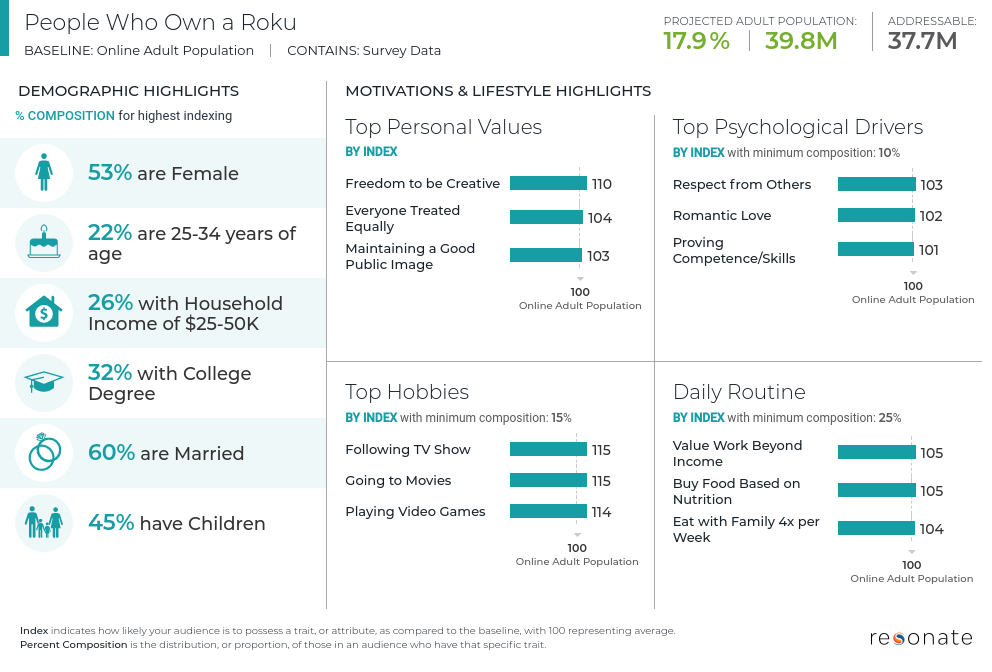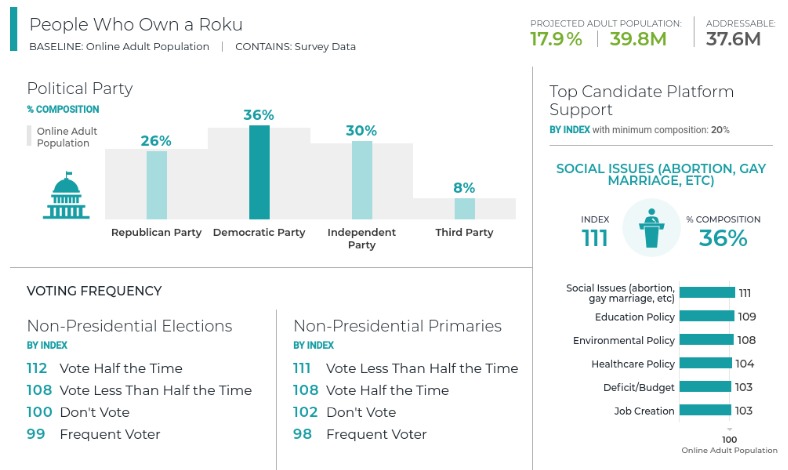If political campaigns don’t have over-the-top (OTT) or Connected TV advertising in their plans for the 2020 elections, a huge opportunity will be missed. The OTT viewing audience is growing rapidly, and it offers a new and modern opportunity for political campaigns to reach a growing segment of voters.
There are more video streaming service subscribers worldwide at 613.3 million than those with a cable connection at about 556 million users, says the Motion Picture Association of America. Hulu alone had 25 million subscribers in 2018 and $1.5 billion in advertising revenue. The streaming service now has more subscribers than any traditional pay-TV provider.
Advertisers are lining up for opportunities to reach these viewers – the U.S. OTT ad market expanded 54% in 2018 and will grow another 39% in 2019, making it the fastest-growing segment of the ad-supported media marketplace. That’s well ahead of social and digital video.
WHAT’S THE POTENTIAL?
The terminology around this new medium is highly confusing to most people. In this blog post, we’ll focus on OTT and Connected TV. OTT is the delivery of film and TV content over the internet, without having to subscribe to a traditional cable or satellite pay-TV service, according to Digiday. Connected TV is similar but considered a subset of OTT where the content is only viewed on a TV.
Some of the biggest providers include Amazon, Hulu, Netflix and Roku, along with several TV networks like CBS, Showtime and Lifetime. Now companies like Apple, Disney and Target are launching similar services. Not all offer advertising opportunities, but many are going in that direction. NBCUniversal recently announced it would launch a free, ad-supported OTT service by the middle of 2020, according to The Drum. The company’s chairwoman of advertising and partnerships, Linda Yaccarino, said it was the “largest initiative” in the company’s history.
While there’s been lots of talk about “cord cutting,” where people are ditching their cable TV service completely, most of the trend right now is “cord stacking,” where people are keeping their cable TV subscription and paying for an additional streaming service of some kind. The big question is how many streaming services people will adopt. At some point, there will be a limit, but no one knows the number quite yet.
WHY SHOULD POLITICAL CAMPAIGNS CAPITALIZE ON CONNECTED TV?
For political campaigns, OTT reaches this growing number of eyeballs and offers increased frequency to a high-value target audience. It’s also a more efficient use of ad dollars, especially in expensive markets.
Political advertising on OTT grew 200% in 2018 from 2016, according to Telaria. The growth is fueled by the broad reach afforded by OTT and the ability for campaigns to hit highly specific geotargeted audience segments, including key swing vote groups and undecided voters, according to Forbes. OTT and Connected TV also provide political advertisers with the benefit of shorter ad blocks and guarantees that their ads will not become lost amidst a sea of other advertising.
It also gives campaigns some assurance that their ads won’t run next to inappropriate or embarrassing content. This has always been a concern on digital and social sites. With OTT, campaigns can get demographic and geographic targeting, without having to worry about context or viewability and fraud. Another benefit is that Connected TV ad serving technology cuts down on duplicative ads, or ads running alongside their opponent’s messages.
Campaigns will also be able to reach young voters through OTT and Connected TV, which has always been a challenge. The largest age segment among cord cutters is people ages 25-34, according to Resonate insights. This same age group dominates the audience of people who watch TV and movies through streaming services but haven’t necessarily cut off their cable provider.
WHERE TO START
The Resonate consumer intelligence platform can help campaigns launch and expand their OTT strategy by first tapping into over 12,000 insights describing 200 million U.S. online adults, including people located in 179 DMAs and 422 Congressional districts. Let’s look at the 40 million people who own a Roku over-the-top device, which allows them to stream all kinds of ad-supported digital content. This segment is mostly made up of married women between ages 25-44. Most of them are homemakers and over half don’t have children.

People’s daily decisions, including who and what issues they support, are largely driven by personal values. The Roku user’s top personal value is having the freedom to be creative. They also believe everyone should be treated equally, and maintaining a good public image is important to them.
When it comes to psychological drivers, they want respect from others, they seek out or nurture romantic love and they focus on proving their competence and skills.
It’s no surprise that the Roku consumer is a screen lover. They spend their free time following TV shows, going to the movies and playing video games. When not watching a screen, their daily routine includes valuing their work beyond the income, buying nutritious food and eating with family at least four times per week.
Now that we understand their daily lives, we can drill into their political views. This segment is nearly split evenly between the Democratic party, Republican party and Independents, making them highly coveted swing voters. Most of them vote half the time in non-presidential elections and they vote less than half the time in non-presidential primaries.

They’re largely made up of Professional Progressives, who are the most educated and wealthy group of voters and the most active, followed by Loyal Lefties, who are the most liberal and Democratic and disapprove of the current administration more than any other voter. (Check out our Voter Landscape Ebook to learn more about today’s voters.)
Their top three social issues of interest are social issues like abortion and gay marriage, followed by education policy and environmental policy.
These types of insights help formulate the right messaging. But what about reach? The Resonate customer intelligence platform allows campaigns direct access to connected TV audiences. After developing specific audiences to reach, including down to the Congressional district of interest, campaigns have turnkey activation to a media partner. Even if the campaign doesn’t have access to a connected TV platform, the Resonate team of experts can help.
Now is the time to start developing your OTT strategy. Let us show you how your campaign can tap into OTT and Connected TV audiences efficiently.
Categorized as: Blog Page, Politics & Advocacy


